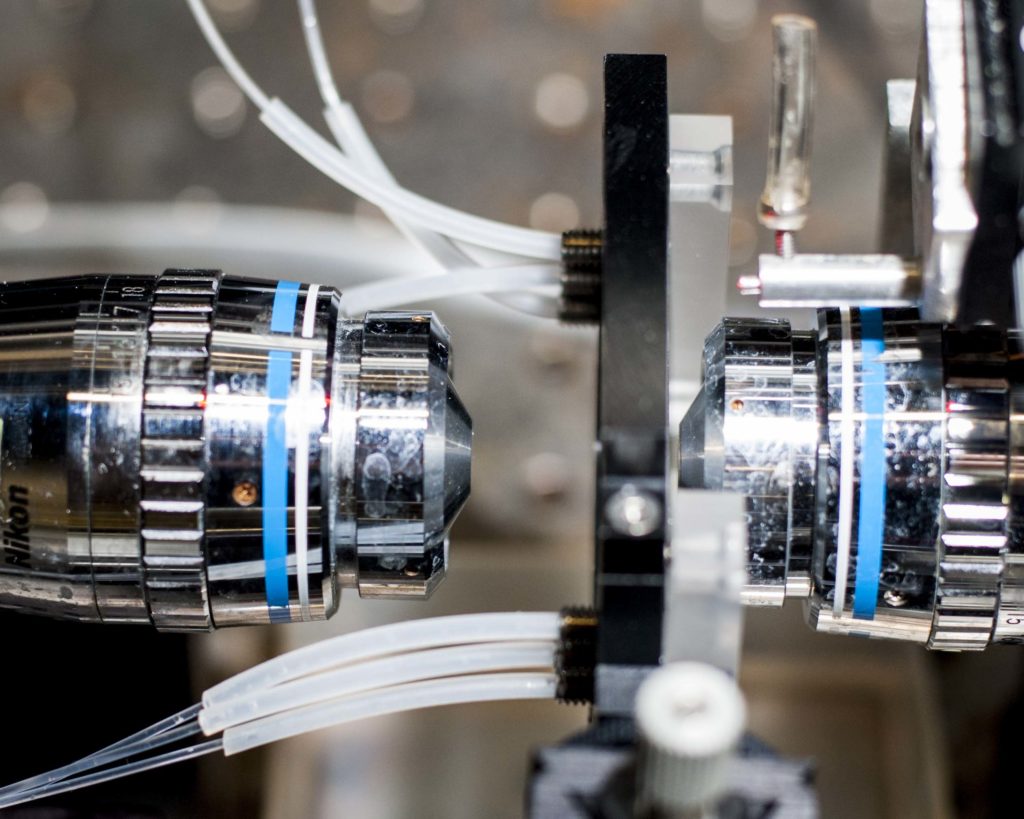From pv magazine España
On October 2, the Swedish Academy of Sciences awarded the Nobel Prize in Physics 2018 to three scientists: Arthur Ashkin (New York, United States), Donna Strickland (Guelph, Ontario, Canada), and Gérard Mourou (Albertville, France), for their contributions to the development of “light tools” and their studies on laser beams, with multiple applications in medicine and industrial processes.
Arthur Ashkin is the inventor of the so-called “optical tweezers”, a device capable of catching microscopic objects, even on a nanoscale, thanks to the pressure exerted by light on the object that is illuminated.
Ricardo Arias-González, a researcher at the Madrid Institute of Advanced Studies (IMDEA) Nanoscience, pioneered the introduction of optical tweezers in biology in Spain, and produced the instrument with which he researches in his Cantoblanco laboratory.
The advances of photonics can be applied to medicine, but they can also result in the manufacture of more efficient solar cells. As Arias González explains to pv magazine, “A laser can be viewed for many purposes as a gun, shooting photons in almost linear trajectories. These light bullets go through the physical objects pushing or modifying their trajectories in complex ways. By focusing the light rays it is possible to trap a neutral particle in three dimensions. More in depth, the total force on a particle can be split into two main components: the scattering force, which pushes the particle along the incident beam, and the gradient force, which points towards the centerline of the beam and is responsible for the trapping.”
pv magazine: What is the instrument known as optical tweezers?
Ricardo Arias González: It is an optical assembly, with lasers and microscope lenses, which allows micro and nanoscopic objects to be confined in the three dimensions of space. In addition, it functions as a dynamometer sensitive to very small forces, forces in the Newton-peak, which are the interesting range in biology, for example.
Why is it so important to biology?
The biology of the last century experienced a tremendous advance by the incursion of physicists, who with advanced microscopy instruments (x-ray diffraction, electron microscopy) managed to find out more about the elemental molecules of life. Optical tweezers are a technique also introduced by physicists, which allows molecules to be picked up as if they were objects and to study their mechanical properties. In particular, in the study of proteins, it is possible to study them as if they were nanomachines.
What has been your role in this field at the national level?
During my thesis, I developed theory and simulations on optical forces, which are the forces developed by the photons that make up electromagnetic radiation when hitting material objects. After a post-doctorate applied in molecular biology at the University of California, Berkeley, I learned how to develop optical tweezer instruments, being the first to implement this technology in Spain.
How can solar cell research benefit?
Mainly to increase precision in the investigation of the materials used. Light as a laboratory instrument has always been associated with seeing things, especially making microscopy. The optical tweezers use the light for a different application. They pick up very small things, as if you were using a very small hand and without making any material contact.
Specifically, they allow manipulating atoms, molecules and nanoparticles, as well as whole cells or their organelles, and explore their properties in isolation. Conventional techniques handle collectivities of specimens in such a way that they only access average behaviors, properties of the set. The possibility of accessing nanostructured materials, such as those used in photovoltaic cells, one by one, allows more precision when studying their interaction with sunlight or energy transduction.
This content is protected by copyright and may not be reused. If you want to cooperate with us and would like to reuse some of our content, please contact: editors@pv-magazine.com.



By submitting this form you agree to pv magazine using your data for the purposes of publishing your comment.
Your personal data will only be disclosed or otherwise transmitted to third parties for the purposes of spam filtering or if this is necessary for technical maintenance of the website. Any other transfer to third parties will not take place unless this is justified on the basis of applicable data protection regulations or if pv magazine is legally obliged to do so.
You may revoke this consent at any time with effect for the future, in which case your personal data will be deleted immediately. Otherwise, your data will be deleted if pv magazine has processed your request or the purpose of data storage is fulfilled.
Further information on data privacy can be found in our Data Protection Policy.